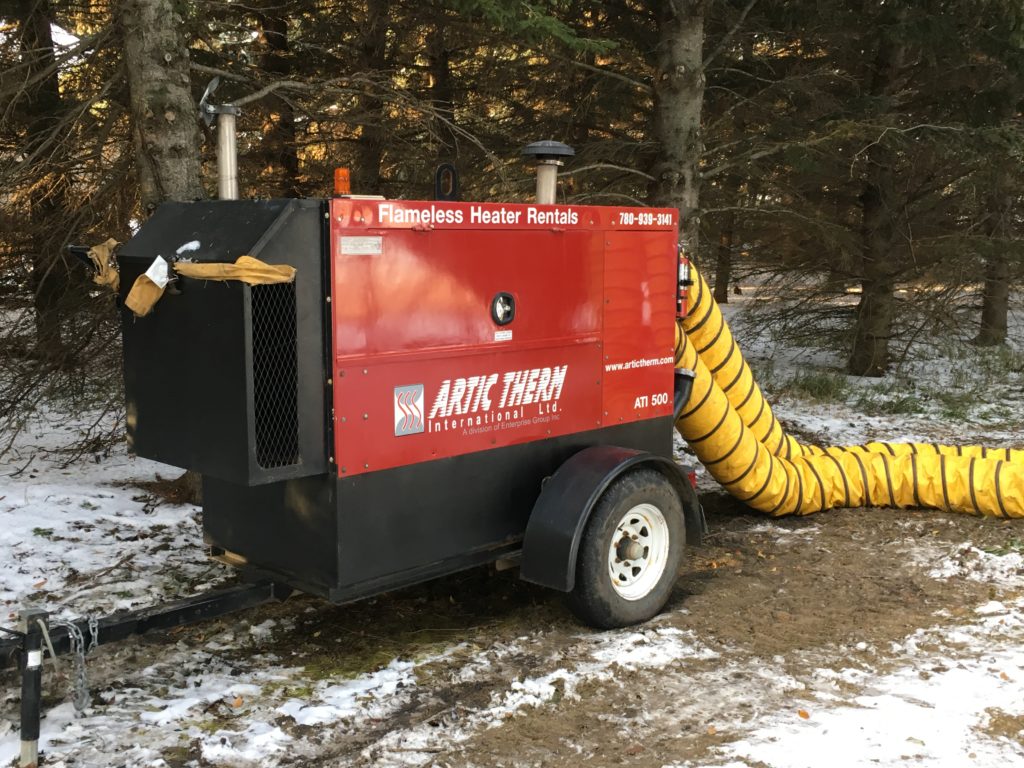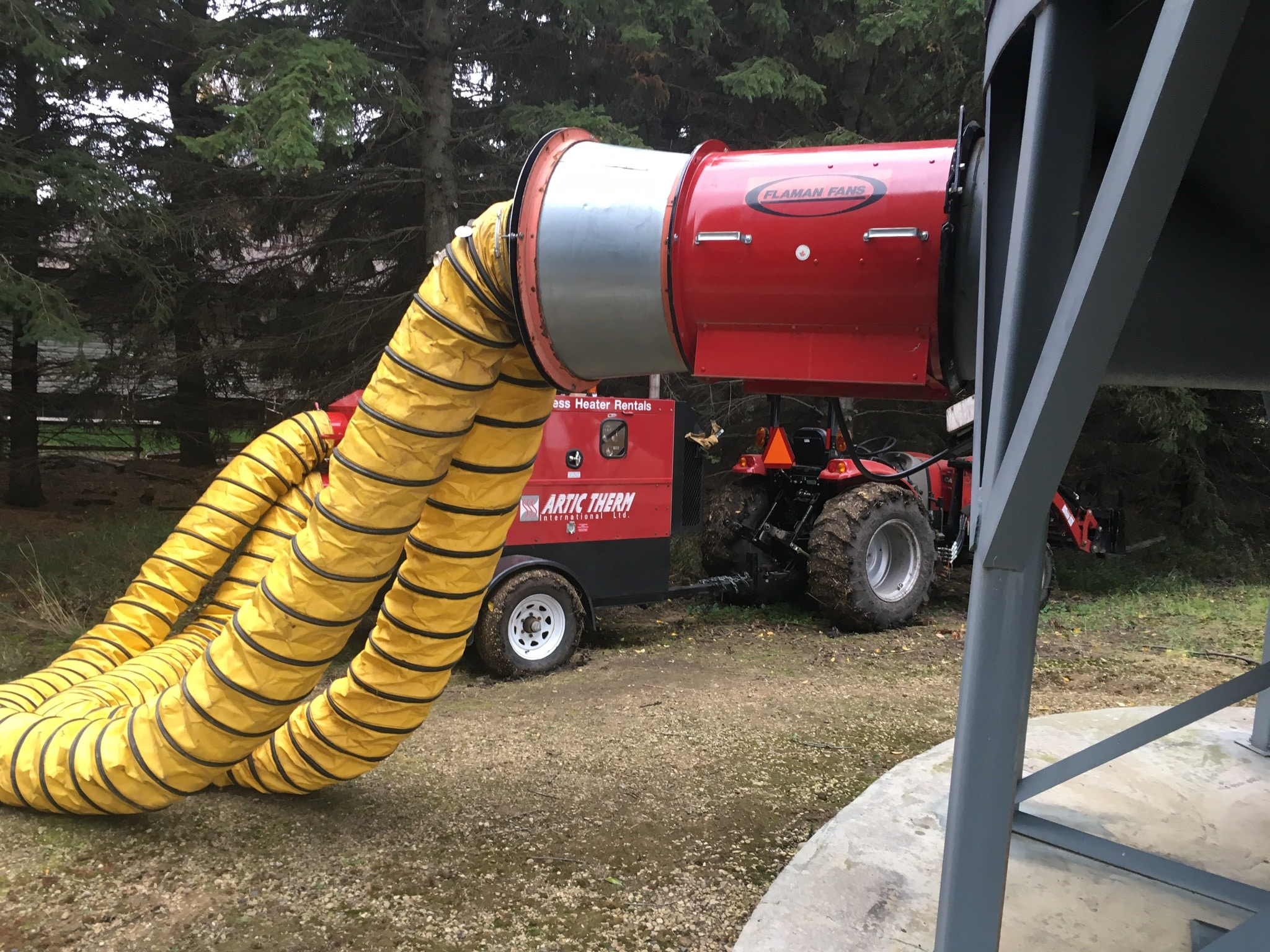A three-year study from Team Alberta is looking at what the cost of drying grain in Alberta really is.
Grain drying has become more common on farms across the Prairies, especially in Alberta, over the last decade. The process is required some years to keep grain in optimal condition, however little data is known exactly what the costs of it are.
“One of the big things that we find in grain storage in Prairies is a lack of information in terms of what is the efficiency of grain drying systems with the current size of equipment,” Lorne Grieger, an agricultural engineer at the Prairie Machinery Institute (PAMI), says in phone interview. “That was a real gap when you start looking at what is the energy consumption? And how does that fit into, what’s the current price of the commodities as well as production costs with an eye to the towards the future.”
The full cost of using grain dryers has also been in the headlines, after the federal government implemented a carbon tax in 2019. Initially, grain drying was not exempt from the tax, which increased drying costs substantially. However, earlier this year the federal government announced there would be tax rebates coming for grain drying.
To take a closer look at the cost, Team Alberta, which includes Alberta Barley, Alberta Canola, Alberta Pulse Growers and the Alberta Wheat Commission, started a three-year study in 2019 under the Canadian Agricultural Partnership (CAP). The group contracted PAMI to provide technical assistance on the project, while farmers across Alberta volunteered to provide on farm data about their own grain dryers. 3D Energy Limited is also involved and in charge of data collection and analysis.
The Grain Drying Study
For the three-year study, select in-bin supplemental drying systems and heated air-drying systems in Alberta were monitored during the 2019 and 2020 harvest seasons to assess the typical energy consumption farmers experienced. Equipment was installed on participating farmers’ bins allowing for data collection to be done.
“This allowed us to put things in perspective in terms of what are the different types of systems producers are currently using on the farms, and then understanding some of the variations and putting those into buckets to try and gain a greater depth of knowledge for the grain drying systems,” Grieger explains.
In 2019, the first year of the study allowed researchers to gather initial data and fine tune any gaps they found. In the second year more data was collected, and then the third year is for reviewing collected data.

Both indirect and direct-fired systems were studied to understand the impact on efficiencies for in-bin supplemental heating systems. A total of 36 in-bin systems and five continuous grain dryers were monitored. Energy consumption per tonne of moisture removed (specific energy) was the chosen energy performance metric.
“One of the things we saw quite interesting initially was higher efficiency going between the two different styles of systems. Then, the third year now allows us to really get into what does this mean when you have a greater number of sample points to say, with a greater certainty as to what proficiency can be and the differences as well,” Grieger says.
Jason Lenz is one of the farmers who took part in the study. The director with the Alberta Wheat Commission runs Lenz Farms Ltd., a 2,000-acre grain and oilseed farm, with a 25-cow calf operation, near Bentley, Alta. He has been using a diesel-powered flameless heater grain dryer on his farm for the past five years.
“Grain drying really is quite common in our area… we are one of the shortest growing seasons across the Prairies here. Mainly because we are located so closely to the Rocky Mountains here,” Lenz explains in a phone interview. “We get quite large temperature changes from daytime to nighttime, where we do get cooler nights than a lot of other areas and Prairies.”
As part of the study, Lenz collected data, writing down various information, including the amount of fuel used, the temperature of the air going into the bin, the moisture of the grain going in and the moisture of the grain after.
Results of the Study and Future Plans
With two years of the study now done, there are some things that have been discovered. In the first year of the study, there were a wide range of efficiencies found for in-bin supplemental heating systems noted. The most efficient systems had an efficiency three to four times higher than the others.
It was discovered indirect-fired in-bin supplemental heating systems had higher efficiencies than expected. In-bin supplemental heating systems also ran higher supply temperatures than suggested. Some heated air-drying systems were also found to have higher efficiencies than specified.
Lenz was impressed by the results from his grain dryer with the study. The study results showed the efficiency of his system dried grain quite fast. However, there were some disadvantages as it doesn’t give a uniform dry throughout the bin.
The system we’re using is “certainly not the same as a conventional grain dryer where they can dry every bushel of grain to a certain level of moisture. But if you don’t have a grain dryer, this is a good alternative,” Lenz says.
Lenz says he does plan to take a closer look at the cost of his current flameless grain dryer to a conventional gas burning unit moving forward. If the finances line up, he may consider making the switch.
Grieger expects the study won’t just be able to help farmers in Alberta, but farmers across the Prairie provinces as there is a lack of data on grain drying in each province.
“I think producers are going to be able to take from the study when they see results is to look at their own operations, and then make informed decisions in terms of how they’re currently doing the grain drying process,” Grieger says.
The final report on the study will be released in the spring of 2022.
Header photo — A diesel-powered flameless heater grain dryer hooked up to a bin on Lenz Farms Ltd. by Bentley, Alta. Photo: Jason Lenz
Related Articles
Looking Towards a Greener Future for Ag





